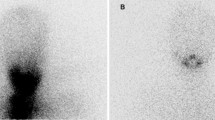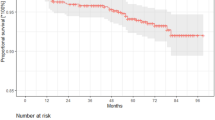Abstract
The purpose of this study was to determine the natural temporal trends of serial thyroglobulin (Tg) among low/intermediate-risk PTC patients not receiving radioactive iodine (RAI) using TSH-stimulated Tg (Stim-Tg) and unstimulated highly sensitive Tg (u-hsTg). We prospectively analyzed serial Stim-Tg measurements after total thyroidectomy ± therapeutic central neck dissection among 121 consecutive low/intermediate-risk PTC patients who did not receive RAI, of whom 104 also had serial u-hsTg measurements available. Median follow-up was 6.5 years with Stim-Tg measurements commencing 3 months after surgery and u-hsTg commencing 1.8 years after surgery (when the assay became available). TSH stimulation was performed with 9-day T3 withdrawal, 22-day T4 withdrawal, or using recombinant human TSH (rhTSH). To account for within-patient correlations of repeated Tg measurements, temporal trends in Stim-Tg and u-hsTg were assessed using Generalized Estimating Equations. Stim-Tg models were adjusted for the method of TSH stimulation, whereas the u-hsTg models were adjusted for concurrent TSH level. Linear regression modeling was used to assess the trend in serial Stim-Tg and u-hsTg measurements as a function time from time of surgery throughout the duration of follow-up. The main outcome measured was the change in u-hsTg and Stim-Tg measurements over time. A total of 337 Stim-Tg (2.8/patient) and 602 u-hsTg (5.8/patient) measurements were analyzed. Among the 337 Stim-Tg measurements, Stim-Tg was assessed using rhTSH in 202 (60 %), T4 withdrawal in 41 (12 %), and T3 withdrawal in 94 (28 %) measurements. The overall mean ± 1SD for Stim-Tg and u-hsTg measured was 1.0 ± 1.2 and 0.2 ± 0.1 μg/L, respectively. When adjusted for method of TSH stimulation, serial Stim-Tg measurements did not significantly change over time (all p = NS). The estimated changes in Stim-Tg per year for rhTSH, T4 withdrawal, and T3 withdrawal were 0.01, −0.08, and 0.04 μg/L, respectively. Upon exclusion of 73 patients with an initial undetectable Stim-Tg (n = 48), serial Stim-Tg measurements did not change significantly over time (all p = NS). For these patients, the estimated changes in Stim-Tg per year for rhTSH, T4 withdrawal, and T3 withdrawal were −0.09, −0.10, and 0.01 μg/L, respectively. Serial u-hsTg measurements did not significantly change over time after adjusting for TSH level (p = NS). The estimated change in u-hsTg per year was −0.003 μg/L. No patients had any clinical or imaging evidence of a recurrence during the duration of their follow-up. Among low/intermediate-risk PTC patients not treated with RAI, serial post-surgical Stim-Tg and u-hsTg measurements do not change significantly over a median follow-up of 6.5 years.
Similar content being viewed by others
References
D.S.A. McLeod, A.M. Sawka, D.S. Cooper, Controversies in primary treatment of low-risk papillary thyroid cancer. Lancet 381(9871), 1046–1057 (2013). doi:10.1016/S0140-6736(12)62205-3
A.M. Sawka, K. Thephamongkhol, M. Brouwers, L. Thabane, G. Browman, H.C. Gerstein, Clinical review 170: a systematic review and metaanalysis of the effectiveness of radioactive iodine remnant ablation for well-differentiated thyroid cancer. J. Clin. Endocrinol. Metab. 89(8), 3668–3676 (2004). doi:10.1210/jc.2003-031167
A. Vaisman, S. Orlov, J. Yip, C. Hu, T. Lim, M. Dowar, J.L. Freeman, P.G. Walfish, Application of post-surgical stimulated thyroglobulin for radioiodine remnant ablation selection in low-risk papillary thyroid carcinoma. Head Neck 32(6), 689–698 (2010). doi:10.1002/hed.21371
S. Orlov, F. Salari, L. Kashat, J.L. Freeman, A. Vescan, I.J. Witterick, P.G. Walfish, Post-operative stimulated thyroglobulin and neck ultrasound as personalized criteria for risk stratification and radioactive iodine selection in low- and intermediate-risk papillary thyroid cancer. Endocrine 50(1), 130–137 (2015). doi:10.1007/s12020-015-0575-0
R.P. Padovani, E. Robenshtok, M. Brokhin, R.M. Tuttle, Even without additional therapy, serum thyroglobulin concentrations often decline for years after total thyroidectomy and radioactive remnant ablation in patients with differentiated thyroid cancer. Thyroid 22(8), 778–783 (2012). doi:10.1089/thy.2011.0522
C. Durante, T. Montesano, M. Attard, M. Torlontano, F. Monzani, G. Costante, D. Meringolo, M. Ferdeghini, S. Tumino, L. Lamartina, A. Paciaroni, M. Massa, L. Giacomelli, G. Ronga, S. Filetti, Long-term surveillance of papillary thyroid cancer patients who do not undergo postoperative radioiodine remnant ablation: is there a role for serum thyroglobulin measurement? J. Clin. Endocrinol. Metab. 97(8), 2748–2753 (2012). doi:10.1210/jc.2012-1123
T.E. Angell, C.A. Spencer, B.D. Rubino, J.T. Nicoloff, J.S. LoPresti, In search of an unstimulated thyroglobulin baseline value in low-risk papillary thyroid carcinoma patients not receiving radioactive iodine ablation. Thyroid 24(7), 1127–1133 (2014). doi:10.1089/thy.2013.0691
C. Spencer, J. LoPresti, S. Fatemi, How sensitive (second-generation) thyroglobulin measurement is changing paradigms for monitoring patients with differentiated thyroid cancer, in the absence or presence of thyroglobulin autoantibodies. Curr. Opin. Endocrinol. Diabetes Obes. 21(5), 394–404 (2014). doi:10.1097/med.0000000000000092
S. Orlov, D. Orlov, M. Shaytzag, M. Dowar, V. Tabatabaie, P. Dwek, J. Yip, C. Hu, J.L. Freeman, P.G. Walfish, Influence of age and primary tumor size on the risk for residual/recurrent well-differentiated thyroid carcinoma. Head Neck 31(6), 782–788 (2009). doi:10.1002/hed.21020
D.S. Cooper, G.M. Doherty, B.R. Haugen, R.T. Kloos, S.L. Lee, S.J. Mandel, E.L. Mazzaferri, B. McIver, F. Pacini, M. Schlumberger, S.I. Sherman, D.L. Steward, R.M. Tuttle, Revised American thyroid association management guidelines for patients with thyroid nodules and differentiated thyroid cancer. Thyroid 19(11), 1167–1214 (2009). doi:10.1089/thy.2009.0110
A. Golger, T.R. Fridman, S. Eski, I.J. Witterick, J.L. Freeman, P.G. Walfish, Three-week thyroxine withdrawal thyroglobulin stimulation screening test to detect low-risk residual/recurrent well-differentiated thyroid carcinoma. J. Endocrinol. Invest. 26(10), 1023–1031 (2003)
A. Toft, G. Beckett, Use of recombinant thyrotropin. Lancet 359(9321), 1874–1875 (2002). doi:10.1016/s0140-6736(02)08785-8
A.E. Hubbard, J. Ahern, N.L. Fleischer, M. Van der Laan, S.A. Lippman, N. Jewell, T. Bruckner, W.A. Satariano, To GEE or not to GEE: comparing population average and mixed models for estimating the associations between neighborhood risk factors and health. Epidemiology 21(4), 467–474 (2010). doi:10.1097/EDE.0b013e3181caeb90
C.A. Spencer, L.M. Bergoglio, M. Kazarosyan, S. Fatemi, J.S. LoPresti, Clinical impact of thyroglobulin (Tg) and Tg autoantibody method differences on the management of patients with differentiated thyroid carcinomas. J. Clin. Endocrinol. Metab. 90(10), 5566–5575 (2005). doi:10.1210/jc.2005-0671
A. Algeciras-Schimnich, M.A. Lasho, K.M. Ness, L.A. Cheryk, S.K. Grebe, The Roche Elecsys and Siemens-Centaur thyroglobulin autoantibody assays show comparable clinical performance to the recently unavailable Beckman-Coulter access thyroglobulin autoantibody assay in identifying samples with potentially false-low thyroglobulin measurements due to thyroglobulin autoantibody interference. Thyroid 21(7), 813–814 (2011). doi:10.1089/thy.2011.0158
S. Edge, D.R. Byrd, C.C. Compton, A.G. Fritz, F.L. Greene (eds.), A.T.: AJCC Cancer Staging Manual, 7 ed (Springer, New York, 2010)
C. Nascimento, I. Borget, F. Troalen, A. Al Ghuzlan, D. Deandreis, D. Hartl, J. Lumbroso, C.N. Chougnet, E. Baudin, M. Schlumberger, S. Leboulleux, Ultrasensitive serum thyroglobulin measurement is useful for the follow-up of patients treated with total thyroidectomy without radioactive iodine ablation. Eur. J. Endocrinol. 169(5), 689–693 (2013). doi:10.1530/eje-13-0386
P.W. Rosario, G.F. Mourao, T.L. Siman, M.R. Calsolari, Serum thyroglobulin measured with a second-generation assay in patients undergoing total thyroidectomy without radioiodine remnant ablation: a prospective study. Thyroid 25(7), 769–775 (2015). doi:10.1089/thy.2014.0496
P.W. Rosario, A.F. MineiroFilho, B.S. Prates, L.C. Silva, M.R. Calsolari, Postoperative stimulated thyroglobulin of less than 1 ng/ml as a criterion to spare low-risk patients with papillary thyroid cancer from radioactive iodine ablation. Thyroid 22(11), 1140–1143 (2012). doi:10.1089/thy.2012.0190
Acknowledgments
This study was supported in part by unrestricted educational grants from Abbott/Mylan Laboratories Limited Canada; the Mount Sinai Hospital Foundation of Toronto Da Vinci Gala Fundraiser; the George Knudson Oakdale Pro-Am Charity Golf Tournament; the Mount Sinai Hospital Department of Medicine Research Fund; and the Alex and Simona Shnaider Research Chair in Thyroid Oncology to PGW.
Author information
Authors and Affiliations
Corresponding author
Ethics declarations
Conflict of interest
PGW receives consulting fees from Genzyme Canada, a Sanofi company and a shareholder in Protoecyte Diagnostics Inc. LK, SO, DO, JA, JC, and FS have no relevant disclosures of interest.
Rights and permissions
About this article
Cite this article
Kashat, L., Orlov, S., Orlov, D. et al. Serial post-surgical stimulated and unstimulated highly sensitive thyroglobulin measurements in low- and intermediate-risk papillary thyroid carcinoma patients not receiving radioactive iodine. Endocrine 54, 460–466 (2016). https://doi.org/10.1007/s12020-016-0989-3
Received:
Accepted:
Published:
Issue Date:
DOI: https://doi.org/10.1007/s12020-016-0989-3




